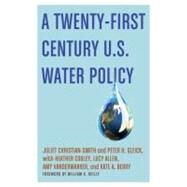A Twenty-First Century U.S. Water Policy
, by Christian-Smith, Juliet; Gleick, Peter H.; Cooley, Heather; Allen, Lucy; Vanderwarker, Amy; Berry, Kate A.; Reilly, William K.- ISBN: 9780199859443 | 0199859442
- Cover: Hardcover
- Copyright: 7/31/2012
As is becoming clearer and clearer, pressures on water resources in the United States are growing, with no foreseeable end in sight. Yet these pressures are not due to a national water scarcity. While the Southwest faces the problems of draught, a rising population, and over-allocation of resources, the Northeast and Northern Plains must deal with increasingly wet weather and flooding. The greatest challenges that the United States faces with regard to water are regional disparities in availability, a changing climate, worsening water quality, and, increasingly, controversies over management strategies and policies. While many countries have adopted federal approaches to water management, the United States has no cohesive national water policy. In fact, the oversight of current water policy is shared by over sixty different agencies,and the last national water assessment undertaken in the United States occurred over forty years ago. The lack of coordinated oversight not only renders national policymakers unable to make informed analyses of water quality standards and availability, it also results in large gaps of understanding regarding variability of water resources and how to most efficiently and effectively manage and preserve those resources.A Twenty-First Century U.S. Water Policyculls together independent analysis of freshwater availability; water usage in agriculture, municipalities, tribal settlements, and energy production; exisiting legal frameworks; environmental justice movements; and data on water quality and climate change. The result is a visionary proposal for a coherent and critically needed federal water policy.






